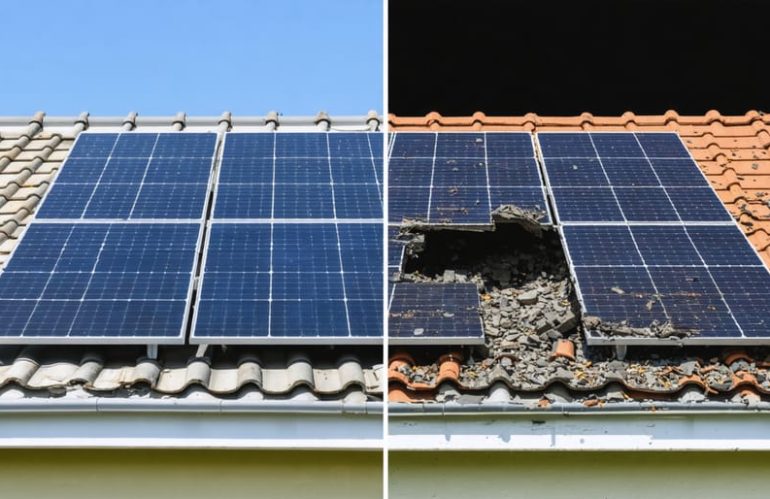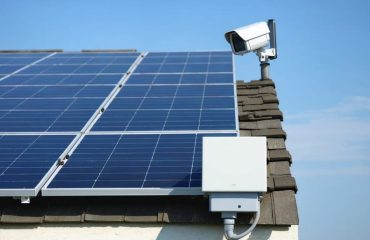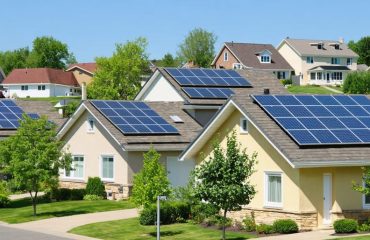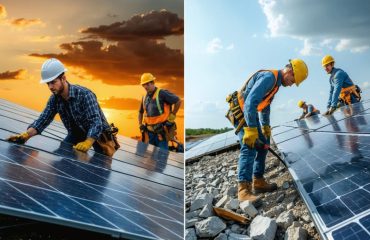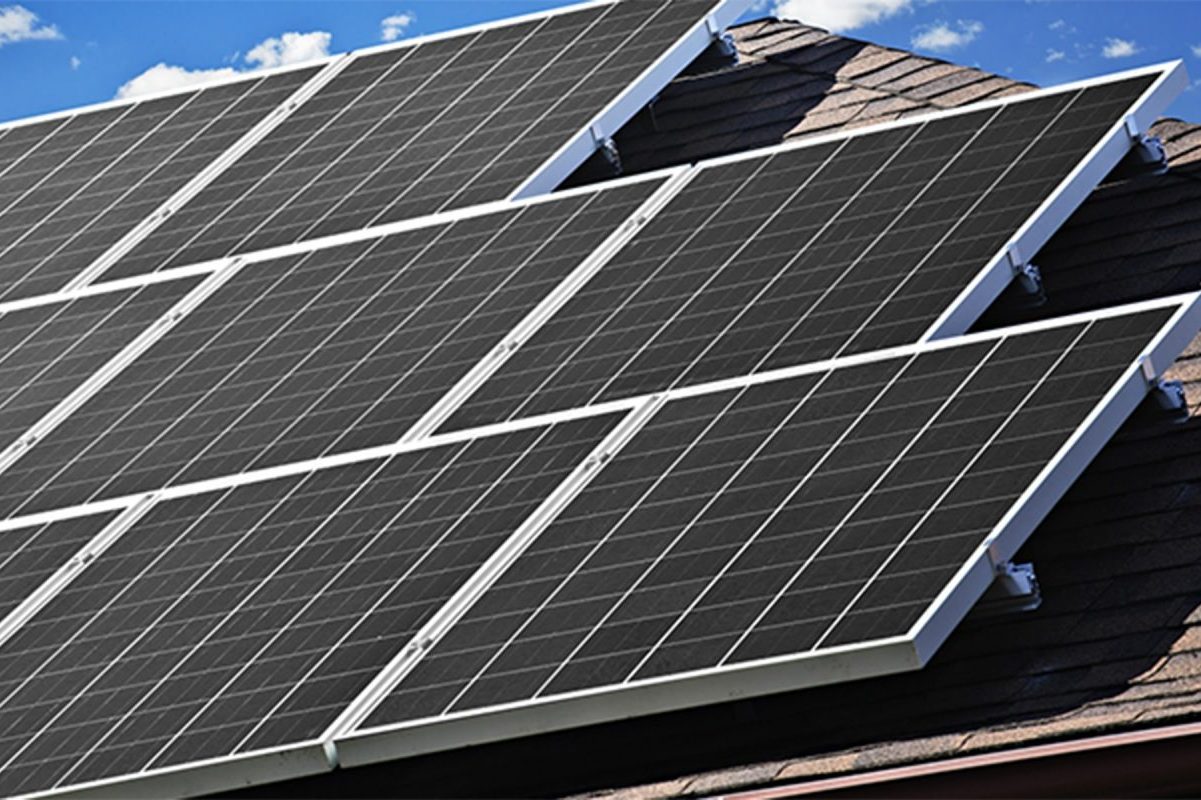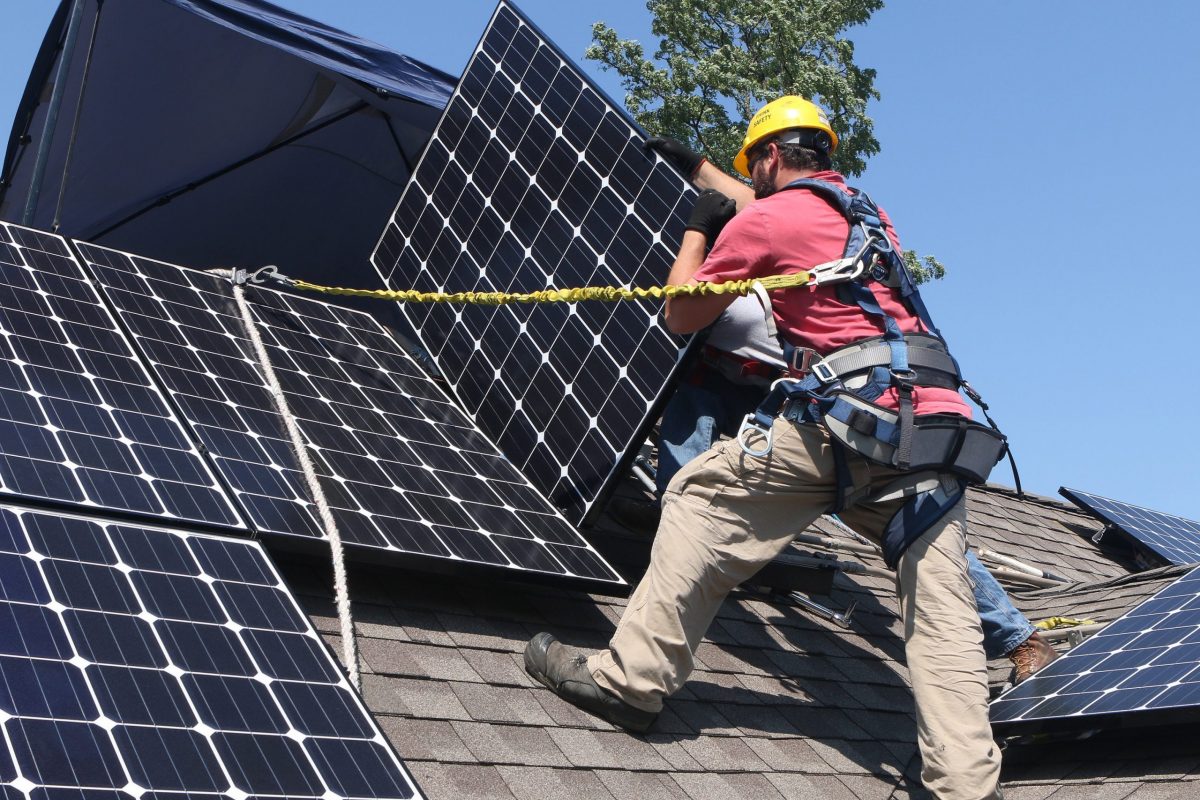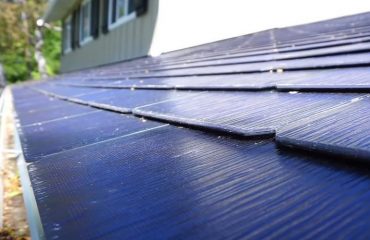Protecting your solar panel investment starts with understanding your insurance coverage options. Most standard homeowners insurance policies include solar panels as part of your home’s structure, typically covering damage from severe weather, fire, or theft. However, the growing complexity of solar technology and increasing installation costs have created unique insurance considerations that every solar homeowner must address.
Performance loss coverage, a critical yet often overlooked aspect, safeguards against efficiency degradation and unexpected output reduction. While basic policies cover physical damage, they may not account for the financial impact of reduced energy production. Smart homeowners are increasingly opting for specialized solar insurance riders that protect both their equipment and its expected energy-generating capability.
Before installing solar panels or reviewing your existing coverage, connect with your insurance provider to verify protection levels and identify potential coverage gaps. Understanding these nuances helps ensure your sustainable energy investment remains secure and profitable for decades to come.
Standard Homeowners Insurance and Solar Panels
What’s Usually Covered
Most homeowners insurance policies cover solar panels as part of your home’s structure, protecting against common perils like fire, wind damage, hail, and falling objects. If your panels are roof-mounted, they’re typically considered a permanent attachment to your house and are covered under your dwelling coverage.
Your policy usually protects against weather-related incidents such as lightning strikes, heavy snow damage, and storm debris. Theft and vandalism of solar equipment are also generally covered, though coverage limits may apply. If a severe storm knocks your panels loose and causes damage to a neighbor’s property, your liability coverage typically handles these claims.
Ground-mounted solar arrays may require additional coverage or a separate policy rider, as they’re not physically attached to your home. Some insurers also cover damage during installation, but it’s important to verify this beforehand. Keep in mind that while physical damage is usually covered, mechanical failures, wear and tear, or manufacturing defects typically aren’t included in standard coverage.
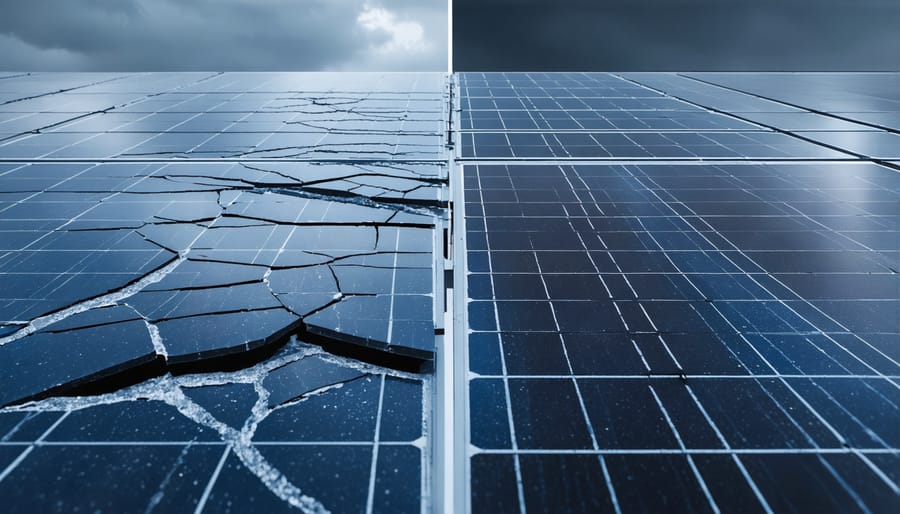
Coverage Limitations
While standard homeowners insurance typically covers solar panels, it’s important to understand common coverage limitations. Most policies don’t cover damage from normal wear and tear, gradual deterioration, or manufacturer defects. Maintenance-related issues, such as loose connections or inverter problems, usually fall outside policy coverage.
Many insurance providers exclude damage caused by earthquakes or floods unless you have specific riders for these events. Performance degradation over time, which is natural for solar panels, typically isn’t covered. Some policies may also have specific exclusions for certain installation methods, particularly DIY installations not performed by certified professionals.
Coverage limits are another consideration. Your policy’s coverage limit must adequately reflect the full value of your solar system. Standard policies might not automatically adjust to include the added value of solar installations, so you’ll need to review and possibly increase your coverage limits.
Additionally, most policies won’t cover business use, so if you’re planning to sell excess energy back to the grid, you should discuss this with your insurance provider to ensure proper coverage.
Performance Loss Coverage Options
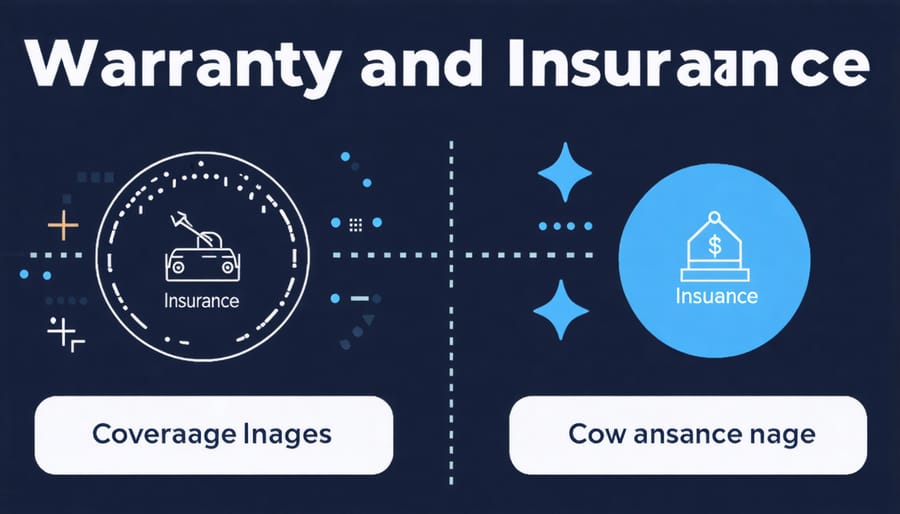
Warranty vs. Insurance Protection
When protecting your solar panel investment, it’s essential to understand the difference between manufacturer warranties and insurance coverage, as they serve distinct purposes. Manufacturer warranties typically cover defects in materials and workmanship, usually lasting 10-25 years for the panels themselves and about 10 years for inverters. These warranties focus on equipment performance and manufacturing issues but don’t protect against external damage.
Insurance coverage, on the other hand, safeguards your solar panels against unexpected events like storms, falling trees, fire, or theft. While warranties won’t help if a hailstorm damages your panels, your insurance policy likely will. Most homeowners insurance policies can be extended to include solar panels as part of your home’s structure, offering comprehensive protection against natural disasters and accidents.
It’s important to note that warranties and insurance work together to provide complete protection. For instance, if your panels underperform due to a manufacturing defect, you’ll rely on the warranty. But if they’re damaged by severe weather, you’ll need insurance coverage. To maximize protection, maintain both active warranty registration and adequate insurance coverage. Consider reviewing your policy limits to ensure they reflect the full value of your solar installation, as replacement costs can be significant.
Remember to document your installation, keep warranty paperwork accessible, and regularly review your insurance coverage to ensure you’re fully protected from all angles.
Specialized Solar Insurance Policies
Beyond standard homeowner’s insurance, specialized solar insurance policies offer comprehensive coverage tailored specifically to solar panel systems. These policies are designed to protect your solar investment with features that traditional insurance might not include.
Performance guarantee insurance is particularly valuable, covering potential efficiency losses and power output shortfalls. These policies typically compensate you if your system generates less electricity than promised, ensuring your energy savings remain consistent with initial projections.
Equipment breakdown coverage specifically addresses mechanical and electrical failures that might occur outside of manufacturer warranties. This includes protection against inverter failures, wiring issues, and other technical malfunctions that could impact system performance.
Some insurers offer weather-specific coverage for solar installations, protecting against damage from extreme conditions like hail, high winds, or heavy snow loads. These policies often include coverage for business interruption losses if you’re participating in solar renewable energy credit (SREC) programs.
Production guarantee insurance is another specialized option, particularly beneficial for those who’ve financed their solar installation based on projected energy savings. This coverage ensures you’re compensated if your system underperforms, helping maintain the financial benefits that motivated your solar investment.
Protecting Your Solar Investment
Insurance Policy Updates
To ensure your solar panels are properly protected, you’ll need to review and potentially modify your existing homeowners insurance policy. Start by contacting your insurance provider to discuss available solar panel insurance coverage options. Many insurers offer specific endorsements or riders for renewable energy systems.
When updating your policy, consider increasing your dwelling coverage to reflect the added value of your solar installation. Be sure to document your system’s cost, including installation expenses and equipment specifications. Some insurance providers may require proof of professional installation and current maintenance records.
Key modifications to discuss with your insurer include:
– Adjusting coverage limits to accommodate the full replacement value
– Adding specific riders for weather-related damage
– Including coverage for power generation loss
– Updating liability protection for grid-connected systems
Remember to review your policy annually, as the value of your solar installation may change over time. Some insurers offer premium discounts for eco-friendly home improvements, so ask about potential savings when updating your coverage.
Documentation Requirements
To ensure a smooth insurance claim process for your solar panels, maintain a comprehensive documentation package. Start by keeping your original purchase and installation receipts, along with warranty information from both the manufacturer and installer. Take clear, dated photographs of your solar panel system immediately after installation and regularly thereafter to document its condition.
Keep detailed maintenance records, including professional inspections, repairs, and cleaning services. These records demonstrate proper system upkeep and can support your claim. Store your solar panel system’s technical specifications, including make, model numbers, and performance ratings.
If you’ve made any modifications or upgrades to your system, maintain documentation of these changes. Additionally, keep records of your system’s energy production through utility bills or monitoring system reports. This information can be crucial when claiming performance-related issues.
In case of damage, take immediate photographs from multiple angles and document the date and circumstances of the incident. Having this documentation readily available will help expedite your insurance claim and increase the likelihood of approval.
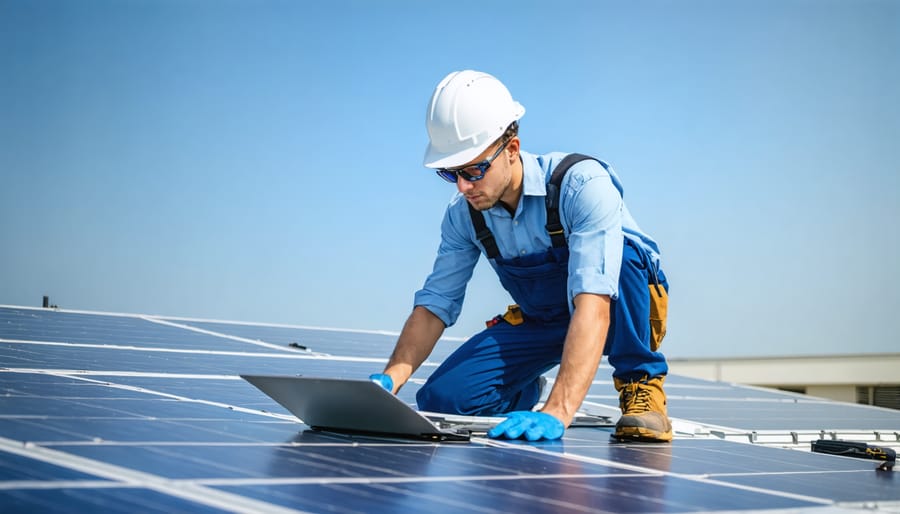
Regular Maintenance Impact
Regular maintenance of your solar panels plays a crucial role in your insurance coverage. Most insurance providers expect homeowners to keep their solar systems in good working condition through routine upkeep. This typically includes cleaning the panels, checking for damage, and ensuring proper functionality of all components.
By maintaining your solar panels according to manufacturer recommendations, you protect both your investment and your insurance coverage. Many policies include clauses that may limit or void coverage if damage occurs due to negligence or poor maintenance. For example, if leaf debris accumulates and causes water damage, your claim might be denied if regular cleaning wasn’t performed.
Most insurers recommend documenting your maintenance activities. Keep records of professional inspections, cleaning sessions, and any repairs. These records can be invaluable when filing a claim, as they demonstrate your commitment to system upkeep. Some insurance companies even offer premium discounts for homeowners who follow a regular maintenance schedule and can prove it with documentation.
Remember, well-maintained solar panels not only ensure continued insurance coverage but also maintain optimal energy production and system longevity.
Understanding your insurance coverage for solar panels doesn’t have to be complicated. As we’ve explored, most homeowners insurance policies do provide basic coverage for solar panels as part of your home’s structure. However, the extent and type of coverage can vary significantly between providers and policies.
To ensure your solar investment is properly protected, take these essential steps: First, contact your insurance provider to verify your current coverage levels and discuss any necessary policy adjustments. Second, consider additional coverage options if you live in an area prone to specific natural disasters or if your basic policy doesn’t provide adequate protection for performance loss.
Remember that while insurance costs might increase slightly when adding solar panels, the long-term benefits often outweigh this expense. The energy savings, increased home value, and potential tax incentives make solar panels a sound investment worth protecting.
For the best coverage, document your solar installation thoroughly, keep maintenance records, and regularly review your policy to ensure it meets your changing needs. If you’re planning to install solar panels, discuss insurance requirements with both your installer and insurance provider before beginning the project.
By taking these proactive steps and maintaining proper insurance coverage, you can enjoy the benefits of solar energy with peace of mind, knowing your investment is protected for years to come.

